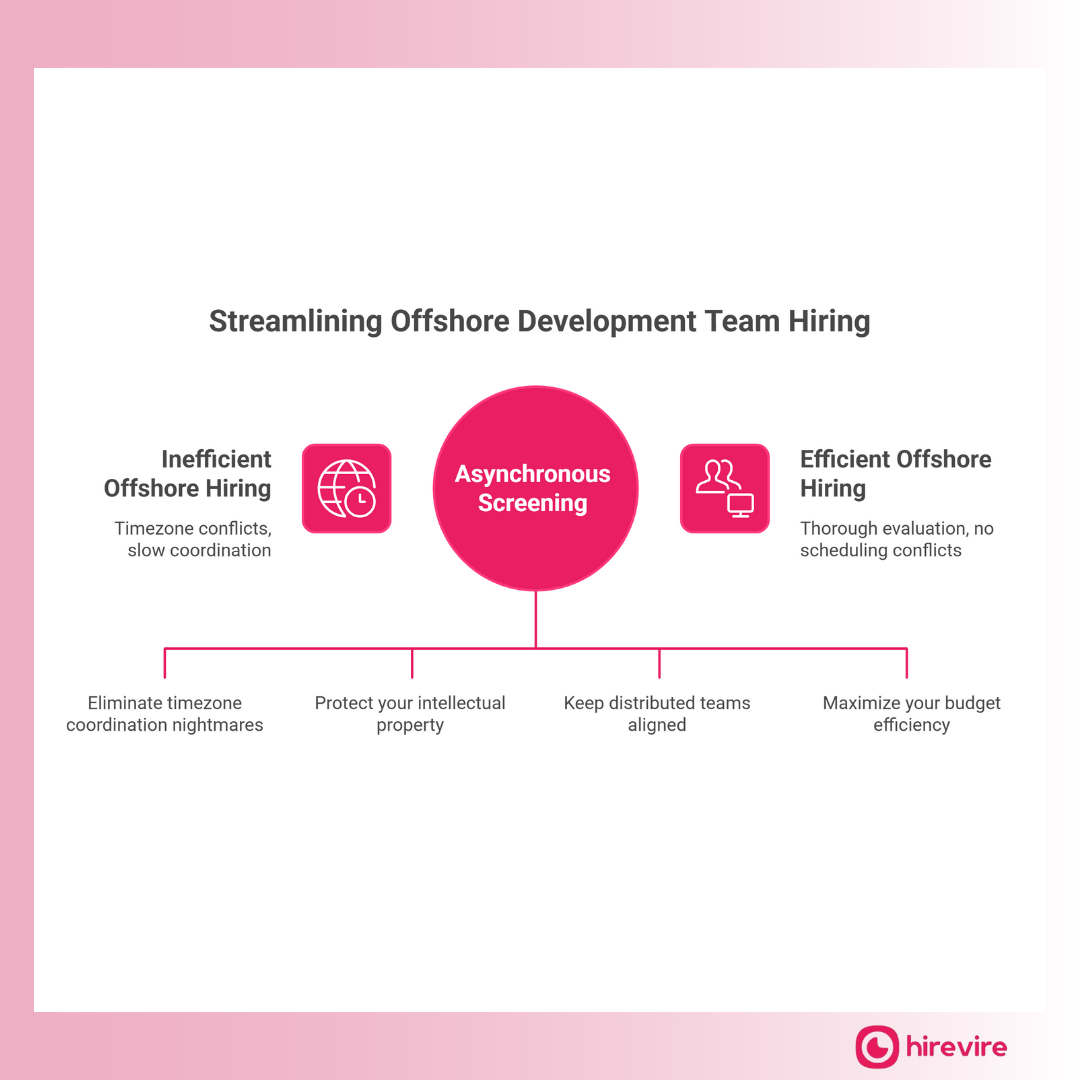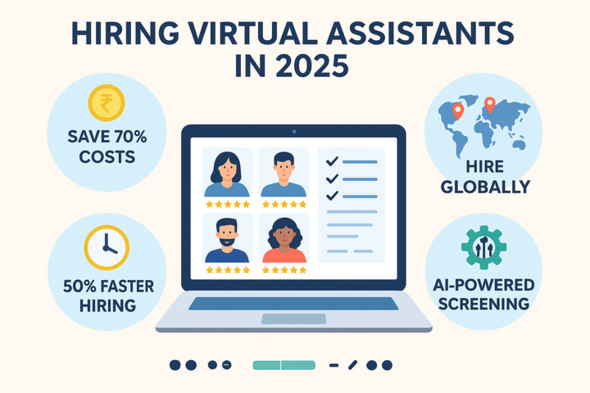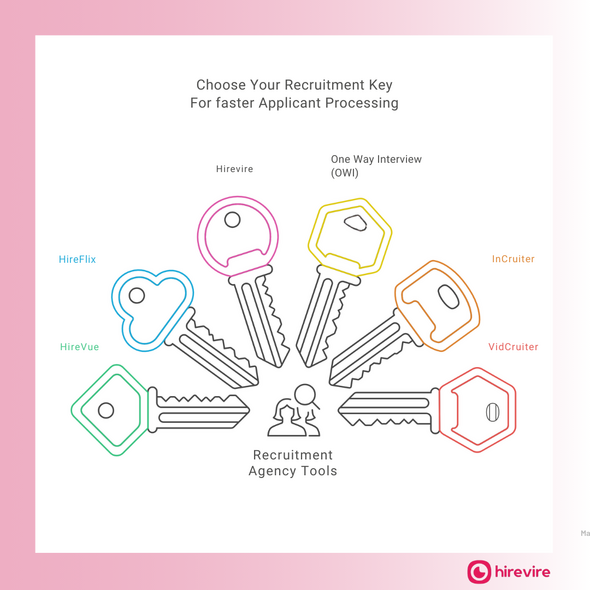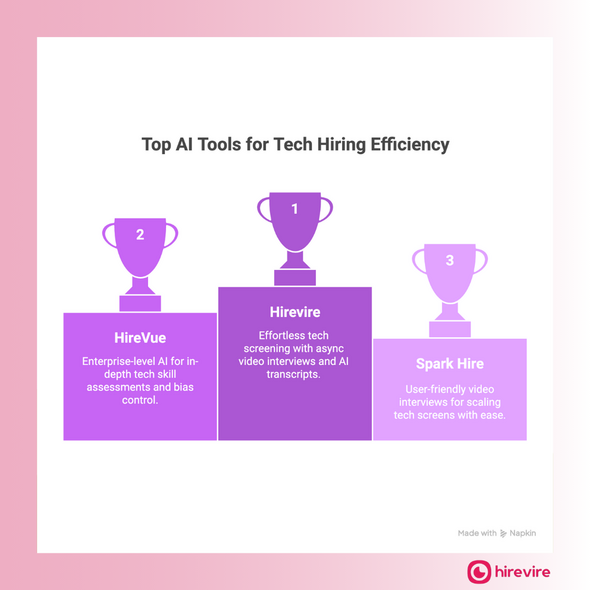Summary:
Hiring offshore development teams offers significant cost savings and access to a global talent pool, but many companies struggle with the screening process due to timezone and coordination challenges. Asynchronous video interviews, like those offered by platforms such as Hirevire, eliminate these issues by allowing candidates to record responses at their convenience, improving evaluation efficiency and candidate experience. This approach, combined with clear communication protocols and robust legal frameworks, enables companies to build effective offshore teams while maintaining quality standards and reducing costs.
Table of Contents
The Hidden Challenge Nobody Talks About
What is Offshore Software Development
Understanding Development Models
Strategic Benefits of Hiring an Offshore team
Best Countries to Hire Offshore Software Engineers
Eastern Europe: Premium Quality Hub
Asia: Scale and Specialization
Latin America: Timezone Champions
Best Practices to Hire Offshore Developers
Implement Thorough Screening Process
Establish Clear Communication Protocols
Legal and Security Considerations
The Screening and Interview Process
Traditional Interview Challenges
The Asynchronous Video Interview Solution: Analyzing Hirevire’s Features
Hirevire Pricing for Offshore Hiring
Essential Questions for Offshore Developer Interviews
Technical Competency Questions
Communication and Collaboration
Problem-Solving and Adaptability
Maximizing Question Effectiveness
Legal and Contractual Considerations
Intellectual Property Protection
Managing Offshore Development Teams
Common Pitfalls and How to Avoid Them
The Best and Platforms for Offshore Hiring
Interview and Screening Platforms
Why Hirevire Excels for Offshore Hiring
Success Stories and Case Studies
Case Study 1: Tech Startup's Offshore Success
Case Study 2: Agency's Offshore Recruitment
Future of Offshore Development
Q: What are the biggest challenges when hiring offshore developers?
Q: How do I ensure quality when hiring offshore developers?
Q: What's the average cost savings when hiring offshore?
Q: How do I handle intellectual property protection?
Q: Which countries are best for hiring offshore developers?
Q: How do I manage communication across different time zones?
Building a world-class development team shouldn't mean breaking the bank or limiting yourself to your local talent pool. Yet most companies approach offshore hiring like they're throwing darts in the dark—hoping to hit the bullseye while blindfolded.
Here's the reality: With over 4.2 million software developers worldwide, the global talent market offers unprecedented opportunities. Companies that master offshore hiring typically save 40-70% on development costs while accessing specialized skills that simply aren't available locally.
But here's where most fail: the screening process.
The Hidden Challenge Nobody Talks About
While everyone focuses on finding developers, the real challenge lies in efficiently evaluating them. Traditional hiring methods create a timezone nightmare when dealing with offshore candidates.
Think about it:
- Scheduling conflicts across multiple time zones
- Endless coordination for basic screening calls
- Team collaboration bottlenecks when sharing candidate feedback
- Inconsistent evaluation due to rushed live interviews
According to research, remote hiring has increased by 135% since 2023, yet companies are still losing an average of 42% of candidates during the interview stage due to these coordination challenges.
What This Guide Delivers
This comprehensive and complete guide cuts through the complexity and shows you exactly how to build exceptional offshore development teams without the typical headaches. You'll discover:
- The best countries and regions for different types of development work
- Proven screening strategies that eliminate timezone coordination nightmares
- Legal frameworks that protect your intellectual property
- Communication systems that keep distributed teams aligned
- Cost analysis tools to maximize your budget efficiency
Most importantly, you'll learn how to hire offshore development team and modern asynchronous screening techniques are revolutionizing offshore hiring—allowing you to evaluate candidates thoroughly without a single scheduling conflict. Let’s dive in.
What is Offshore Software Development
Offshore development involves partnering with software development teams located in different countries, typically offering significant cost advantages and access to specialized skills. This strategic approach has evolved far beyond simple outsourcing into a sophisticated business model that smart companies use to accelerate growth.
Understanding Development Models
Offshore development connects you with remote software developers in distant countries with different time zones, offering maximum cost savings and access to global development talent pools.
Nearshore development involves teams in nearby countries with similar time zones, providing easier collaboration but often at higher costs than offshore alternatives.
Onshore development keeps work domestic, offering maximum control but limiting access to specialized skills and competitive pricing.
Market Growth and Adoption
The offshore development market has reached $24.3 billion globally, driven by compelling business advantages. Key indicators show explosive growth:
- 75% reduction in time-to-hire for organizations using modern recruitment tools
- 135% increase in remote hiring since 2023, according to McKinsey's research
- Video interviewing market growing from $250.06 million to $891.86 million by 2030
Strategic Benefits of Hiring an Offshore team
Cost Efficiency: Companies typically achieve 40-60% cost savings compared to local hiring while maintaining quality standards.
24/7 Development Cycle: Offshore development teams enable continuous progress as work transfers across time zones, effectively doubling productivity.
Access to Global Development Talent: Different regions offer specialized expertise—Eastern Europe excels in fintech, India dominates enterprise software, Latin America leads mobile development.
Scalability: Adding offshore developers doesn't require office expansion, equipment purchases, or navigating local hiring regulations.
Common Engagement Models
Dedicated teams work exclusively on your projects, integrating with your processes and culture for long-term partnerships.
Project-based partnerships deliver fixed-scope work with defined timelines, ideal for specific features or applications.
Staff augmentation adds individual remote software developers to existing teams, filling skill gaps or increasing capacity temporarily.
Success depends entirely on finding the right people—which brings us to the critical challenge of efficiently screening global development talent across time zones and cultural differences.
Best Countries to Hire Offshore Software Engineers
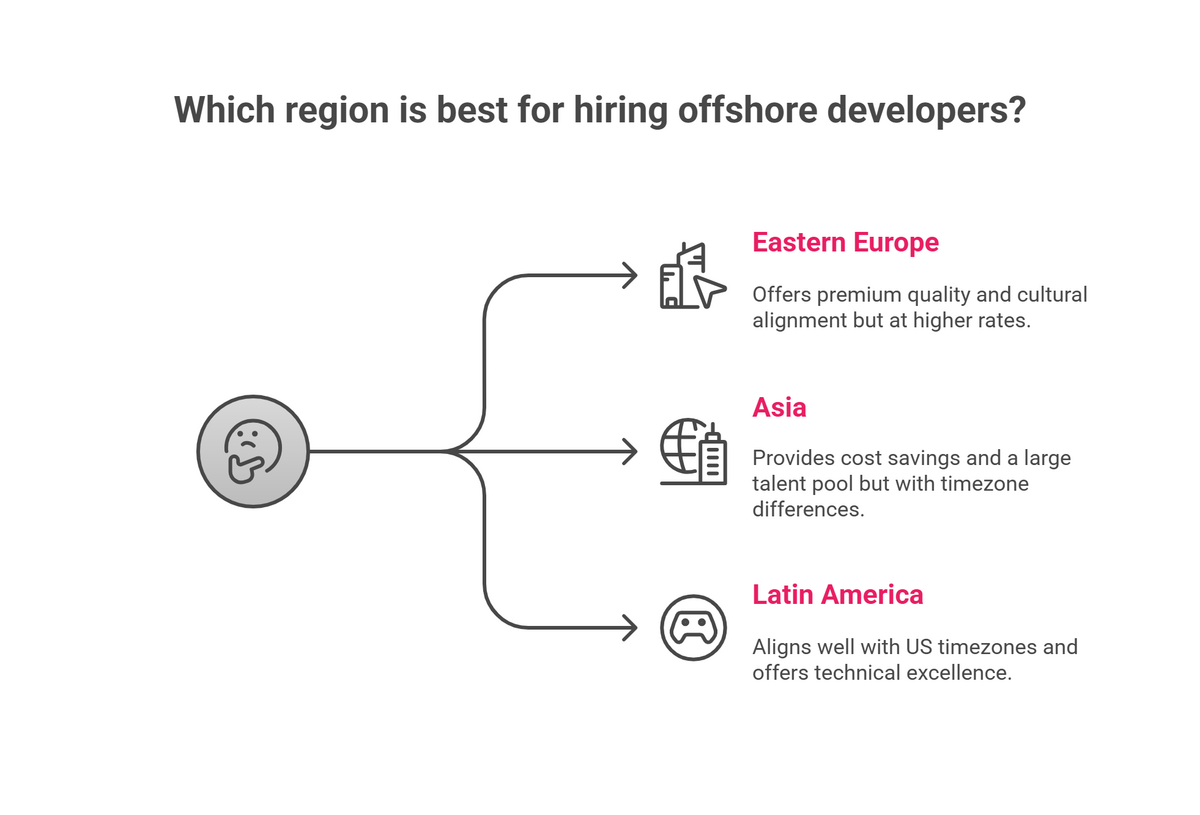
Selecting the right location for your offshore development team directly impacts project success, cost efficiency, and collaboration quality. Each region offers distinct advantages in technical expertise, cultural alignment, and timezone compatibility.
Eastern Europe: Premium Quality Hub
Ukraine: The Tech Powerhouse
- Hourly Rates: $25-50
- Timezone: UTC+2 (excellent European overlap)
- English Proficiency: High
- Specializations: Full-stack development, blockchain, fintech, enterprise solutions
Ukraine's 200,000+ IT professionals have built solutions for WhatsApp, Grammarly, and GitLab. Strong technical education and established IT culture make it ideal for complex projects.
Poland: Enterprise Excellence
- Hourly Rates: $30-60
- Timezone: UTC+1 (perfect European alignment)
- English Proficiency: Very High
- Specializations: Enterprise software, banking solutions, methodical project management
Romania: Emerging Value
- Hourly Rates: $20-45
- Timezone: UTC+2
- Specializations: Web development, mobile apps, game development
Asia: Scale and Specialization
India: Global IT Hub
- Hourly Rates: $15-40
- Timezone: UTC+5:30 (significant US/Europe difference)
- English Proficiency: High (business English standard)
- Specializations: Enterprise software, cloud computing, AI/ML, mobile development
With 4.5+ million developers, India offers the world's largest talent pool. Cities like Bangalore and Hyderabad house major global development centers.
Philippines: Communication Champions
- Hourly Rates: $15-35
- English Proficiency: Excellent (official language)
- Specializations: Web development, customer-facing applications, e-commerce
Vietnam: Rising Star
- Hourly Rates: $15-30
- Specializations: Mobile development, web applications, gaming
China: Innovation Powerhouse
- Hourly Rates: $20-50
- Specializations: Mobile development, AI/ML, IoT, hardware integration
Latin America: Timezone Champions
Argentina: Technical Excellence
- Hourly Rates: $25-50
- Timezone: UTC-3 (excellent US overlap)
- Specializations: Full-stack development, fintech, enterprise solutions
Brazil: Market Leadership
- Hourly Rates: $20-45
- Specializations: E-commerce, mobile development, enterprise software
Mexico: Proximity Advantage
- Hourly Rates: $20-40
- Timezone: UTC-6 to UTC-8 (perfect US alignment)
- Specializations: Web development, mobile apps, e-commerce
Key Decision Factors
Budget Considerations: Eastern Europe offers premium quality at higher rates, Asia provides maximum cost savings with scale.
Timezone Requirements: Latin America aligns with US hours, Eastern Europe suits European operations.
Communication Priorities: Philippines and India excel in English, Eastern Europe offers cultural alignment.
Technical Specialization: Match technology needs with regional strengths—fintech in Ukraine, mobile in Vietnam, enterprise in Poland.
The Critical Insight: Your location choice matters less than your ability to effectively screen candidates. Even the best countries to hire offshore developers have varying quality levels, and cost-effective regions become expensive with wrong hires.
This brings us to the essential question: How do you efficiently identify top talent across these diverse markets and time zones without getting trapped in scheduling nightmares?
Best Practices to Hire Offshore Developers
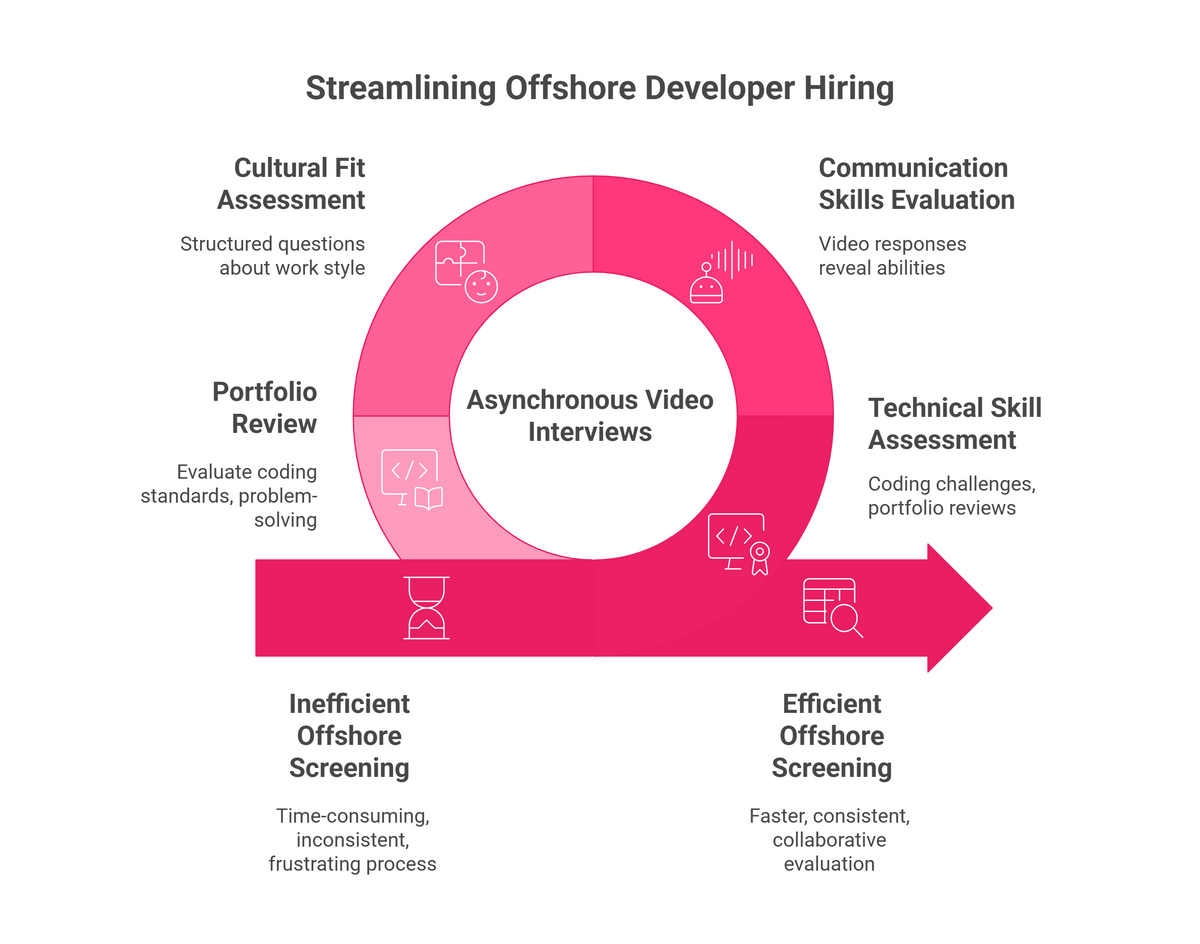
Successfully hiring offshore developers requires a strategic approach that addresses unique challenges while maximizing the benefits of global talent access. These proven best practices eliminate common pitfalls and create sustainable offshore partnerships.
Define Clear Requirements
Create Comprehensive Job Descriptions
Include specific programming languages, frameworks, experience levels, and project scope expectations to attract qualified candidates and prevent miscommunication.
Specify Technical Stack Requirements
Document exact technology requirements including versions, databases, APIs, and integration needs. This precision prevents costly mismatches during project execution.
Establish Communication Standards
Define response times, meeting schedules, reporting formats, and collaboration tools. Clear expectations prevent timezone confusion and maintain momentum.
Set Project Timeline Expectations
Provide realistic deadlines accounting for timezone differences and cultural holidays. Buffer time for onboarding ensures smooth initiation.
Implement Thorough Screening Process
Traditional offshore screening creates logistical nightmares that sabotage hiring success. The biggest challenge companies face when hiring offshore developers isn't finding candidates—it's efficiently evaluating them across timezone barriers.
The Traditional Screening Problem
Companies waste countless hours coordinating live interviews across multiple time zones. Research shows recruiters spend 78% of their hiring time on administrative tasks, while 30-40% of work weeks involve coordinating screening calls. This scheduling complexity leads to:
- Extended hiring timelines due to coordination delays
- Inconsistent evaluation standards across different time zones
- Frustrated candidates abandoning the process
- Hiring teams struggling to collaborate on candidate assessment
- Missed opportunities with top talent in competing time zones
The Asynchronous Video Interview Solution
Smart companies are revolutionizing offshore screening through asynchronous video interviews that eliminate timezone coordination entirely. This approach allows candidates to record responses at their convenience while providing hiring teams comprehensive evaluation materials.
Technical Skill Assessment
Implement coding challenges, portfolio reviews, and technical questionnaires appropriate to role requirements. Asynchronous format allows candidates time to demonstrate skills thoroughly.
Communication Skills Evaluation
Video responses reveal communication abilities, English proficiency, and presentation skills essential for offshore collaboration. Recorded format enables multiple team members to evaluate communication quality consistently.
Cultural Fit Assessment
Structured questions about work style preferences, collaboration approaches, and project management experience help identify candidates who align with company culture.
Portfolio and Code Sample Review
Request relevant work samples that demonstrate coding standards, problem-solving approaches, and attention to detail without scheduling constraints.
Start with Small Projects
Pilot Project Approach
Begin offshore partnerships with limited-scope projects to evaluate collaboration quality, communication effectiveness, and technical capabilities before committing to larger engagements.
Test Collaboration Workflows
Use initial projects to refine communication protocols, establish code review processes, and identify potential challenges in project management approaches.
Build Trust Gradually
Small successes create foundation for larger partnerships while minimizing risk during relationship-building phase.
Establish Clear Communication Protocols
Define Communication Channels
Specify primary platforms for different communication types—instant messaging for quick questions, video calls for complex discussions, project management tools for task tracking.
Set Regular Check-in Schedules
Establish consistent meeting cadence that accommodates timezone differences. Daily standups, weekly progress reviews, and monthly strategic discussions maintain alignment.
Create Documentation Standards
Implement consistent formats for technical documentation, progress reports, and issue tracking. Clear documentation reduces miscommunication and creates reference materials.
Establish Timezone Overlap Requirements
Identify minimum overlap hours for real-time collaboration while respecting work-life balance in both locations.
Legal and Security Considerations
Intellectual Property Protection
Implement comprehensive contracts with clear IP ownership clauses, confidentiality agreements, and non-disclosure provisions. Protect source code and proprietary information through legal frameworks.
Data Security Protocols
Establish security standards for code repositories, communication platforms, and file sharing systems. Implement access controls and encryption requirements.
Contract Structure Optimization
Choose appropriate engagement models—fixed-price for defined projects, time-and-materials for ongoing development, or dedicated team agreements for long-term partnerships.
Compliance Requirements
Address regulatory requirements relevant to your industry and geographic locations. Consider GDPR compliance and data residency requirements.
The Critical Success Factor
Research shows organizations using modern screening tools achieve 67% reduction in screening time per candidate, 50% decrease in cost-per-hire, and 80% improvement in hiring team collaboration. The key differentiator isn't location selection—it's implementing efficient screening processes that evaluate candidates thoroughly without timezone complications.
Companies that master asynchronous evaluation techniques eliminate the scheduling chaos that derails most offshore hiring efforts. This transformation allows focus on candidate quality rather than coordination logistics, resulting in better hires and faster time-to-productivity.
The most successful offshore hiring strategies combine these best practices with modern screening technology that makes geographic distance irrelevant to evaluation quality.
The Screening and Interview Process
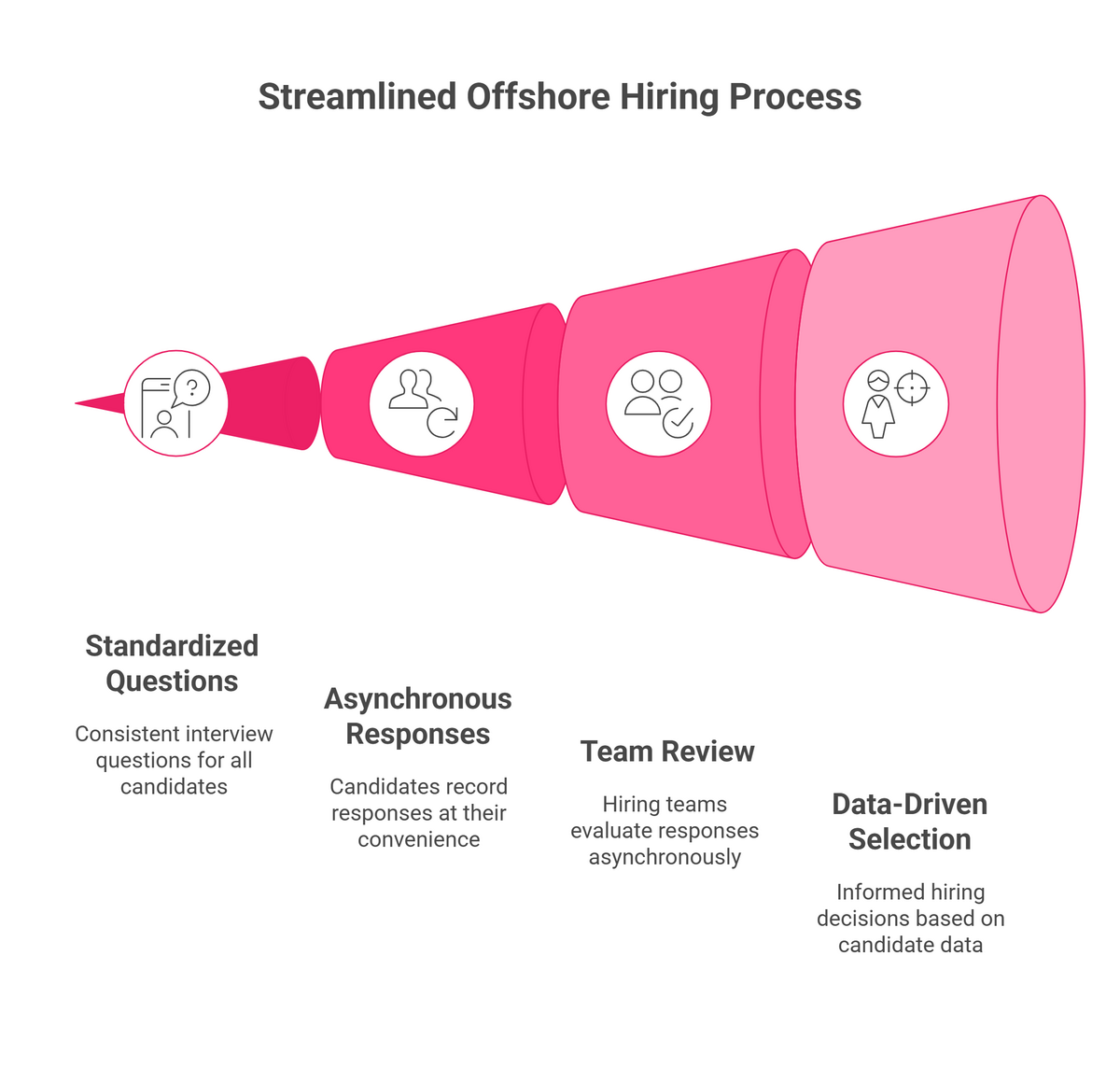
The screening process represents the make-or-break moment in offshore hiring success. While traditional methods create coordination nightmares, modern asynchronous approaches eliminate timezone barriers and improve evaluation quality.
Traditional Interview Challenges
Timezone Coordination Nightmare
Scheduling live interviews across multiple time zones becomes an administrative burden that delays hiring timelines. Companies waste weeks coordinating availability between hiring teams and offshore candidates, often losing top talent to competitors with faster processes.
Scheduling Conflicts Across Multiple Candidates
Traditional screening requires synchronizing calendars across different countries, time zones, and cultural work schedules. This complexity multiplies when evaluating multiple candidates simultaneously, creating bottlenecks that extend hiring cycles unnecessarily.
Inconsistent Evaluation Process
Live interviews conducted at different times with varying team members lead to inconsistent candidate assessment. Timezone pressure forces rushed evaluations that miss crucial skills and cultural fit indicators.
Team Collaboration Bottlenecks
Sharing candidate feedback becomes challenging when team members can't attend live interviews due to timezone constraints. This limitation reduces hiring team input and decision-making quality.
The Asynchronous Video Interview Solution: Analyzing Hirevire’s Features
Hirevire's Approach to Offshore Hiring
Hirevire eliminates timezone coordination entirely through asynchronous video interviews where candidates record responses at their convenience. This revolutionary approach transforms offshore screening from a logistical nightmare into a streamlined evaluation process.
AI Transcripts in 90+ Languages
Crucial for offshore hiring, Hirevire's AI transcription supports over 90 languages, ensuring clear communication assessment regardless of candidate location or accent variations. This feature enables accurate evaluation of English proficiency and technical communication skills.
No Login Required for Global Candidates
Hirevire reduces barriers for international candidates by eliminating login requirements. Candidates simply click a link to record responses, removing technical friction that often causes application abandonment in traditional systems.
Cross-Device Compatibility
Global candidates can participate from any device—smartphone, tablet, or computer—ensuring accessibility regardless of technology limitations in different regions.
Team Collaboration Features
Hiring teams can review recorded responses asynchronously, share feedback, and collaborate on candidate evaluations without scheduling constraints. Multiple stakeholders can assess candidates thoroughly at their convenience.
Step-by-Step Hirevire Process
- Create Standardized Questions: Set up consistent interview questions tailored to offshore developer requirements
- Share Application Links: Send candidates simple links to complete video interviews
- Asynchronous Response Collection: Candidates record video, audio, or text responses at optimal times
- Team Review and Collaboration: Hiring teams evaluate responses and share feedback efficiently
- Data-Driven Selection: Use comprehensive candidate data to make informed hiring decisions
Hirevire Pricing for Offshore Hiring
Starter Plan: $39/month
Perfect for companies hiring single offshore positions, offering unlimited responses and essential collaboration features.
Business Plan: $99/month
Ideal for companies with regular offshore hiring needs, including advanced analytics and team collaboration tools.
Agency Plan: $199/month
Designed for recruitment agencies managing multiple offshore clients with white-labeling and advanced integration capabilities.
The Competitive Advantage
Organizations using Hirevire for offshore hiring report 75% reduction in coordination time, 60% faster time-to-hire, and 85% improvement in candidate experience scores. By eliminating scheduling complexity, companies focus on candidate quality rather than logistical coordination.
This transformation turns offshore hiring from a timezone challenge into a strategic advantage for accessing global talent efficiently.
Essential Questions for Offshore Developer Interviews
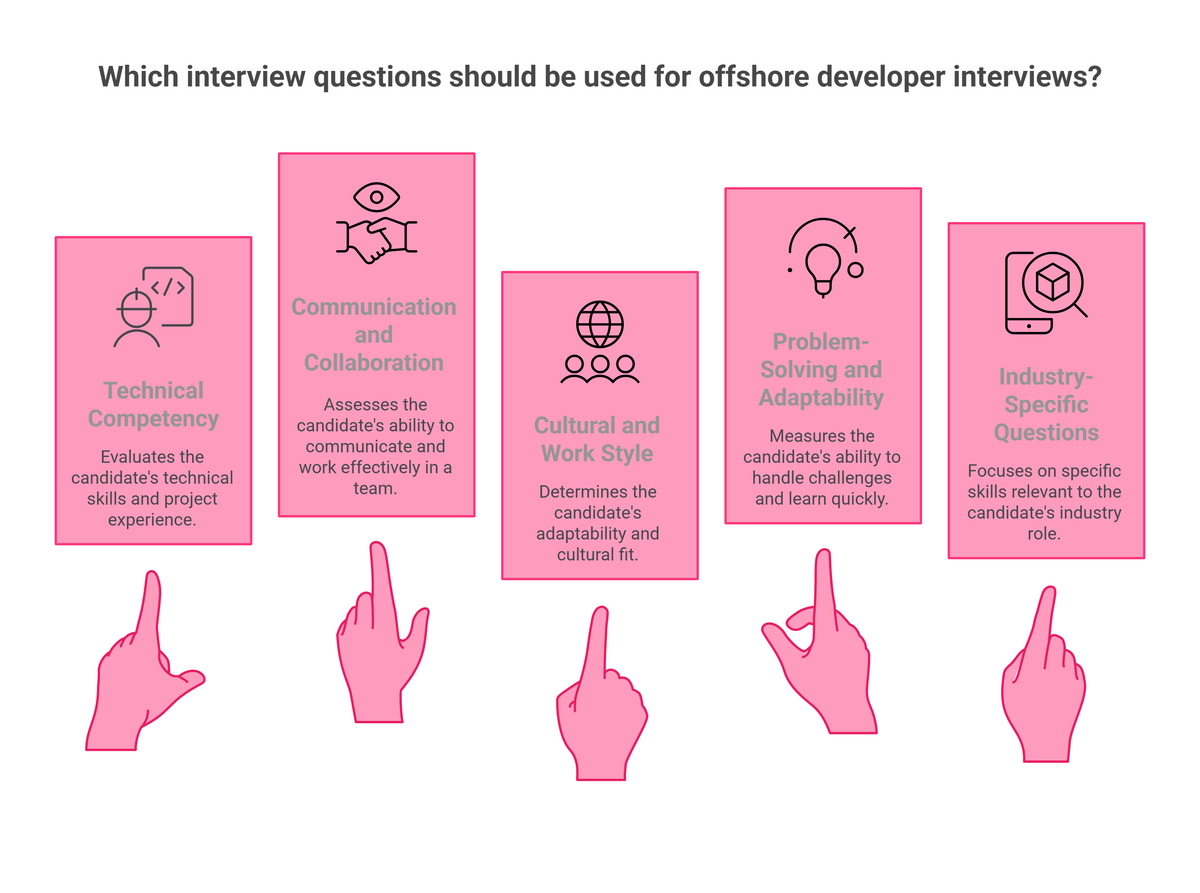
The right interview questions reveal technical competency, communication skills, and cultural fit essential for offshore development success. These curated questions work optimally in asynchronous video formats.
Technical Competency Questions
- "Walk us through your most complex project and the technologies you used"
- "How do you approach debugging in [specific programming language]?"
- "Describe your experience with [specific framework/tool relevant to project]"
- "How do you ensure code quality and maintainability?"
- "Explain your understanding of [specific technical concept]"
Communication and Collaboration
- "How do you handle communication challenges when working with clients in different time zones?"
- "Describe a time when you had to explain a complex technical concept to a non-technical stakeholder"
- "How do you manage your workflow when collaborating with a distributed team?"
- "What tools do you use for project management and communication?"
Cultural and Work Style
- "How do you adapt your communication style for different cultural contexts?"
- "Describe your typical workday and how you manage productivity"
- "How do you handle feedback and criticism of your work?"
- "What motivates you to work with international clients?"
Problem-Solving and Adaptability
- "Tell us about a challenging deadline you faced and how you managed it"
- "How do you stay updated with latest technology trends?"
- "Describe a situation where you had to learn a new technology quickly"
Industry-Specific Questions
For Mobile Developers:
- "Describe challenges you've faced with iOS/Android platform differences"
- "How do you optimize mobile app performance across different devices?"
For Web Developers:
- "Explain your approach to frontend/backend integration and API design"
- "How do you ensure responsive design across browsers and screen sizes?"
For AI/ML Developers:
- "Walk through your algorithm optimization process for large datasets"
- "How do you validate model performance and prevent overfitting?"
For DevOps Engineers:
- "Describe your experience with infrastructure scaling challenges"
- "How do you implement CI/CD pipelines for complex applications?"
Maximizing Question Effectiveness
These questions perform exceptionally well in asynchronous video interview formats where candidates can prepare thoughtful responses showcasing their expertise. Standardized questions enable fair comparison across multiple offshore candidates while providing hiring teams with consistent evaluation criteria.
The combination of strategic questions with asynchronous delivery creates optimal evaluation that reveals candidate quality while respecting global scheduling constraints.
Legal and Contractual Considerations
Establishing robust legal frameworks protects your business interests while creating clear expectations for offshore development partnerships. Proper contractual structure prevents costly disputes and ensures project success.
Here’s a framework:
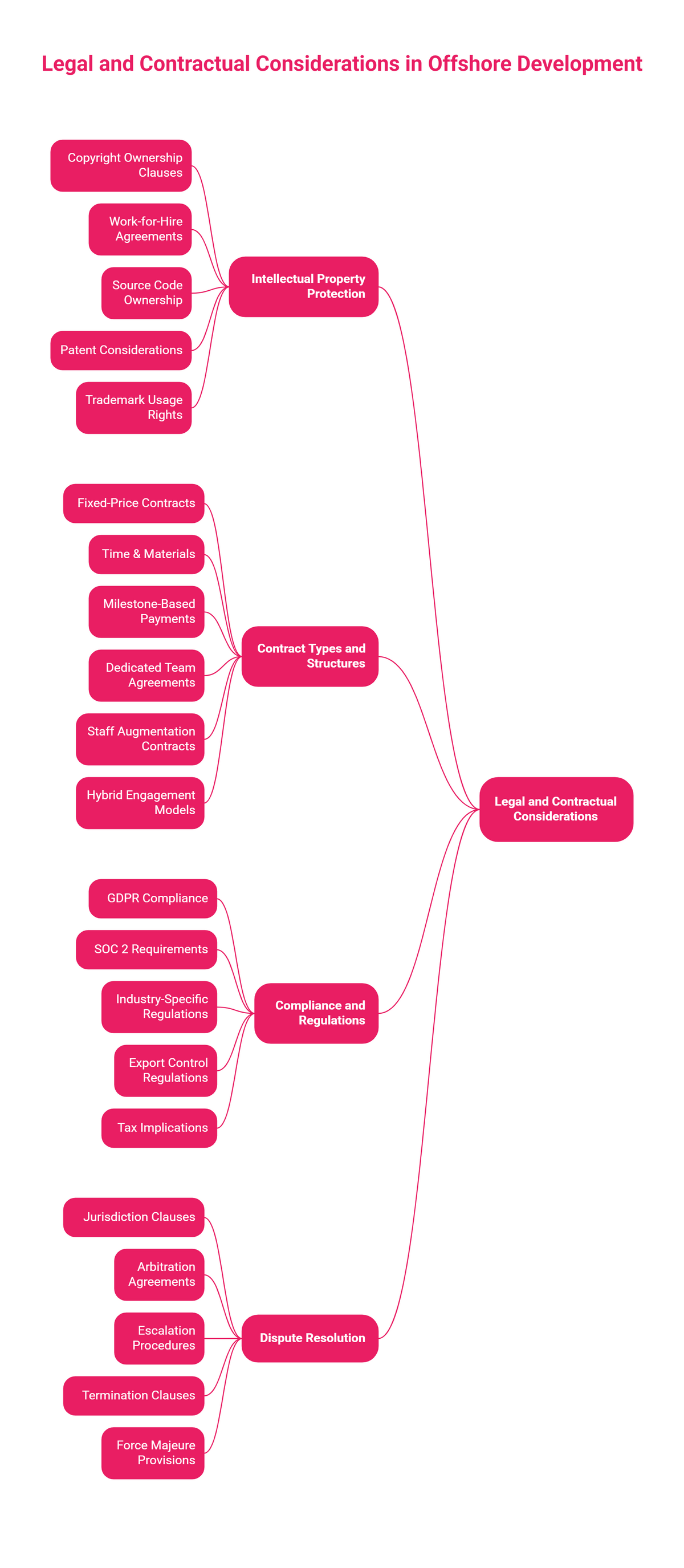
Intellectual Property Protection
Protecting intellectual property represents the most critical aspect of offshore development contracts. Clear ownership clauses prevent future disputes and safeguard competitive advantages.
Copyright Ownership Clauses
Establish explicit copyright ownership transfer from developers to your company upon completion. Include provisions for pre-existing code and third-party libraries.
Work-for-Hire Agreements
Structure contracts as work-for-hire arrangements where possible, automatically transferring IP ownership. This provides strongest protection for custom development work.
Source Code Ownership
Define comprehensive source code ownership including documentation, configuration files, and deployment scripts. Specify escrow arrangements for critical repositories.
Patent Considerations
Address patent rights for innovative solutions developed during projects. Include provisions for patent applications and licensing arrangements.
Trademark Usage Rights
Restrict offshore teams from using your trademarks or brand elements beyond project requirements. Include confidentiality clauses preventing unauthorized usage.
Contract Types and Structures
Selecting appropriate contract structures aligns payment models with project requirements while managing risk effectively.
Fixed-Price Contracts vs. Time & Materials
Fixed-price works for well-defined projects with clear deliverables. Time & materials suit evolving requirements or research-heavy components requiring flexibility.
Milestone-Based Payments
Structure payments around specific deliverables rather than time periods. This ensures quality delivery and provides natural review points.
Dedicated Team Agreements
Long-term partnerships benefit from dedicated team contracts establishing exclusive allocation, consistent rates, and integrated processes.
Staff Augmentation Contracts
Individual developer additions require contracts addressing integration procedures and performance evaluation criteria.
Hybrid Engagement Models
Combine multiple contract types for complex projects requiring different approaches for various components.
Compliance and Regulations
International partnerships must address complex regulatory requirements across multiple jurisdictions and industry standards.
GDPR Compliance for EU Data
European regulations require explicit data processing agreements, privacy assessments, and breach notification procedures. Include cross-border transfer mechanisms.
SOC 2 Requirements
Security-sensitive projects need SOC 2 frameworks addressing availability, security, confidentiality, and privacy controls. Establish audit procedures.
Industry-Specific Regulations (HIPAA, PCI-DSS)
Healthcare projects require HIPAA compliance with business associate agreements. Payment systems need PCI-DSS certification and secure practices.
Export Control Regulations
Technology transfer restrictions may apply to certain software, encryption, or defense-related projects. Review ITAR and EAR requirements.
Tax Implications and Withholding
Understand tax obligations including withholding requirements, treaties, and documentation needs. Consult professionals for complex structures.
Dispute Resolution
Effective mechanisms prevent minor disagreements from escalating while maintaining project momentum.
Jurisdiction Clauses
Specify governing law and court jurisdiction for disputes. Choose jurisdictions with strong IP protection and efficient legal systems.
Arbitration Agreements
Include mandatory arbitration for faster, confidential resolution. Specify rules, location, and arbitrator selection procedures.
Escalation Procedures
Establish clear escalation paths from project management to executive involvement before formal dispute resolution.
Termination Clauses
Define termination conditions, notice periods, and asset transfer procedures. Include IP delivery and confidentiality obligations.
Force Majeure Provisions
Address unforeseeable circumstances including disasters, political instability, or pandemic disruptions affecting delivery timelines.
Managing Offshore Development Teams
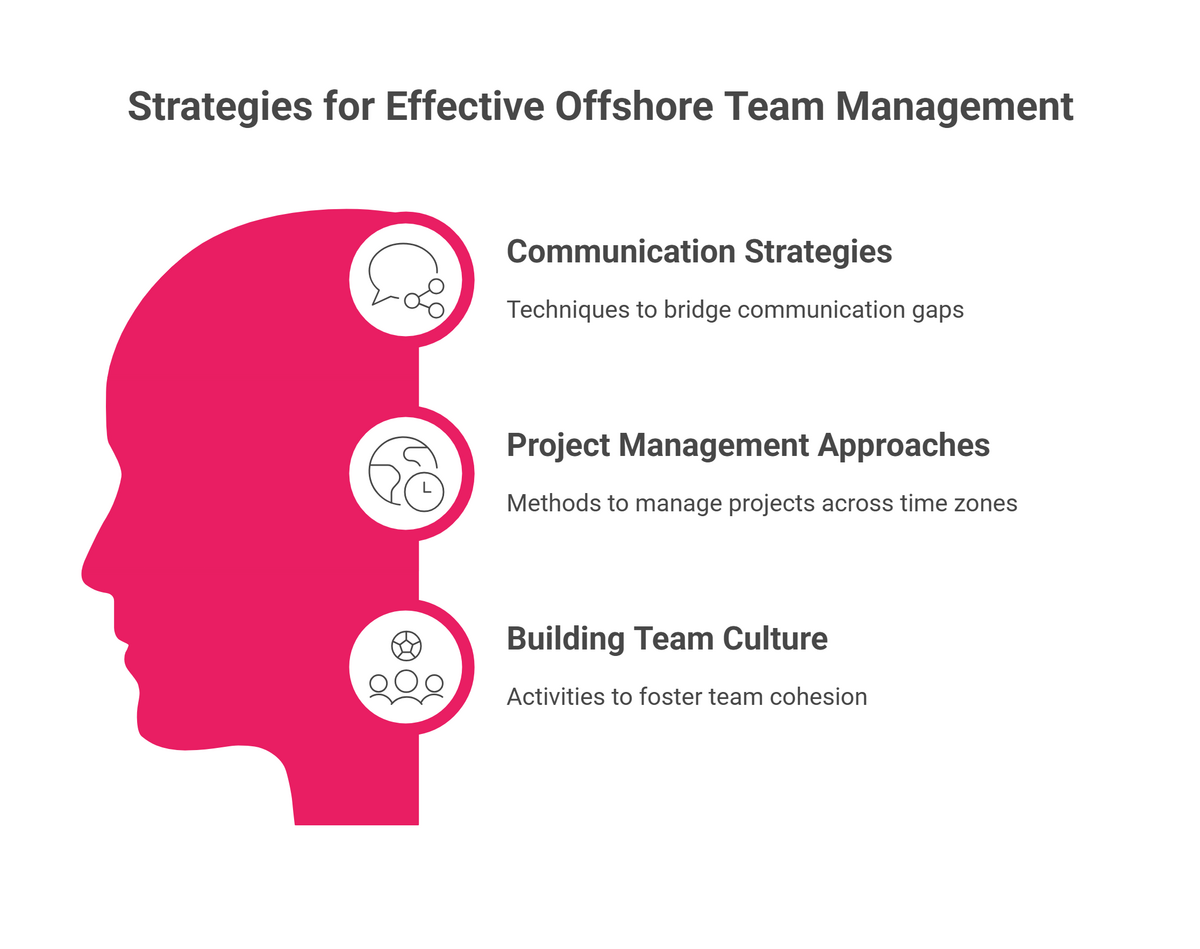
Effective offshore team management requires strategic approaches that bridge geographical distances while maintaining productivity and team cohesion. Success depends on establishing clear communication frameworks and fostering strong relationships.
Communication Strategies
Daily Standups Across Timezones
Schedule daily standups accommodating both onshore and offshore team members. Rotate meeting times weekly to share timezone burden equitably. Use asynchronous updates when live participation isn't feasible.
Comprehensive Documentation
Maintain detailed project documentation including technical specifications, coding standards, and process workflows. Well-documented projects reduce miscommunication and enable effective work during non-overlap hours.
Visual Communication Tools
Leverage screen sharing, digital whiteboards, and visual project management tools to overcome language barriers. Visual communication proves effective for technical discussions and complex problem-solving.
Regular Video Calls for Relationship Building
Schedule regular video conferences beyond work meetings to build personal connections. Face-to-face interaction strengthens working relationships and improves collaboration quality.
Project Management Approaches
Agile Methodologies for Distributed Teams
Implement agile frameworks adapted for distributed teams with emphasis on clear communication and flexible scheduling. Use tools supporting asynchronous collaboration while maintaining agile principles.
Clear Sprint Planning and Deliverables
Establish detailed sprint planning with specific, measurable deliverables and acceptance criteria. Break down complex tasks into components manageable across different time zones.
Regular Retrospectives and Feedback Loops
Conduct sprint retrospectives focusing on communication effectiveness and process improvements. Create safe spaces for offshore team members to share feedback about collaboration challenges.
Progress Tracking and Reporting
Implement transparent progress tracking providing real-time visibility into project status and potential roadblocks. Use dashboards and automated reporting to keep stakeholders informed.
Building Team Culture
Virtual Team Building Activities
It’s important to hire virtual assistants and organize online team building sessions including virtual coffee breaks, games, and collaborative exercises. These activities help offshore team members feel integrated into company culture.
Cultural Exchange Sessions
Facilitate sessions where team members share insights about local customs and work practices. Understanding cultural differences improves collaboration and reduces misunderstandings.
Recognition and Reward Programs
Establish recognition programs acknowledging offshore team contributions equally with onshore achievements. Public recognition and career advancement opportunities demonstrate commitment to success.
Career Development Opportunities
Provide offshore team members with training resources, mentorship programs, and skill development opportunities through conferences, certifications, and knowledge sharing sessions.
Successful offshore team management transforms geographical challenges into competitive advantages by leveraging diverse perspectives and specialized expertise available globally.
Cost Analysis and Budgeting
Understanding the complete cost structure of offshore development enables accurate budget planning and realistic ROI expectations. Successful offshore partnerships require comprehensive analysis beyond basic hourly rates to ensure long-term financial benefits.
Direct Costs
Developer Hourly/Monthly Rates by Region
Eastern Europe ranges from $25-60/hour with Ukraine ($25-50), Poland ($30-60), and Romania ($20-45). Asia offers lower rates: India ($15-40), Philippines ($15-35), Vietnam ($15-30), and China ($20-50). Latin America provides timezone advantages: Argentina ($25-50), Brazil ($20-45), and Mexico ($20-40).
Platform Fees and Recruitment Costs
Modern screening platforms like Hirevire start at $39/month, significantly reducing traditional recruitment expenses. Compare this to average cost-per-hire of $4,700 for conventional methods. Efficient screening tools eliminate scheduling coordination costs while improving candidate quality.
Communication and Collaboration Tools
Budget for project management platforms ($10-50/user/month), video conferencing tools ($15-25/user/month), and file sharing systems ($5-15/user/month). These tools enable effective distributed team collaboration and maintain productivity across time zones.
Legal and Contract Setup Costs
Initial legal framework establishment ranges from $2,000-10,000 depending on complexity and jurisdiction requirements. Include intellectual property protection, compliance documentation, and contract templates for various engagement models.
Hidden Costs
Management Overhead
Offshore team management requires additional coordination effort, typically 15-25% management overhead compared to local teams. Factor in communication time, progress tracking, and cultural bridge-building activities necessary for successful partnerships.
Quality Assurance Requirements
Enhanced QA processes often needed for offshore development, including additional code reviews, documentation verification, and testing protocols. Budget 10-20% additional time for quality assurance activities and process refinement.
Training and Onboarding
Initial offshore team onboarding requires 2-4 weeks depending on project complexity. Include time for technical training, process documentation, and cultural integration activities that ensure smooth team integration.
Currency Fluctuation Risks
Exchange rate variations can impact long-term contracts significantly. Consider hedging strategies or local currency contracts to minimize financial exposure from currency fluctuations over project duration.
ROI Calculation Framework
Cost Comparison: Offshore vs. Local Hiring
Calculate total cost including salaries, benefits, office space, and equipment. Offshore development typically delivers 40-60% cost savings while accessing specialized skills unavailable locally.
Quality Metrics and Delivery Timelines
Measure success through code quality scores, project delivery timelines, and defect rates. Well-managed offshore teams often match or exceed local team performance while providing cost advantages.
Long-Term Partnership Value
Consider relationship building benefits, knowledge retention, and process optimization over time. Established offshore partnerships become increasingly efficient, delivering greater value as collaboration matures.
Scalability Benefits
Factor in rapid scaling capabilities without infrastructure investment. Offshore teams enable quick capacity increases during peak periods without long-term commitments or facility expansion costs.
Common Pitfalls and How to Avoid Them
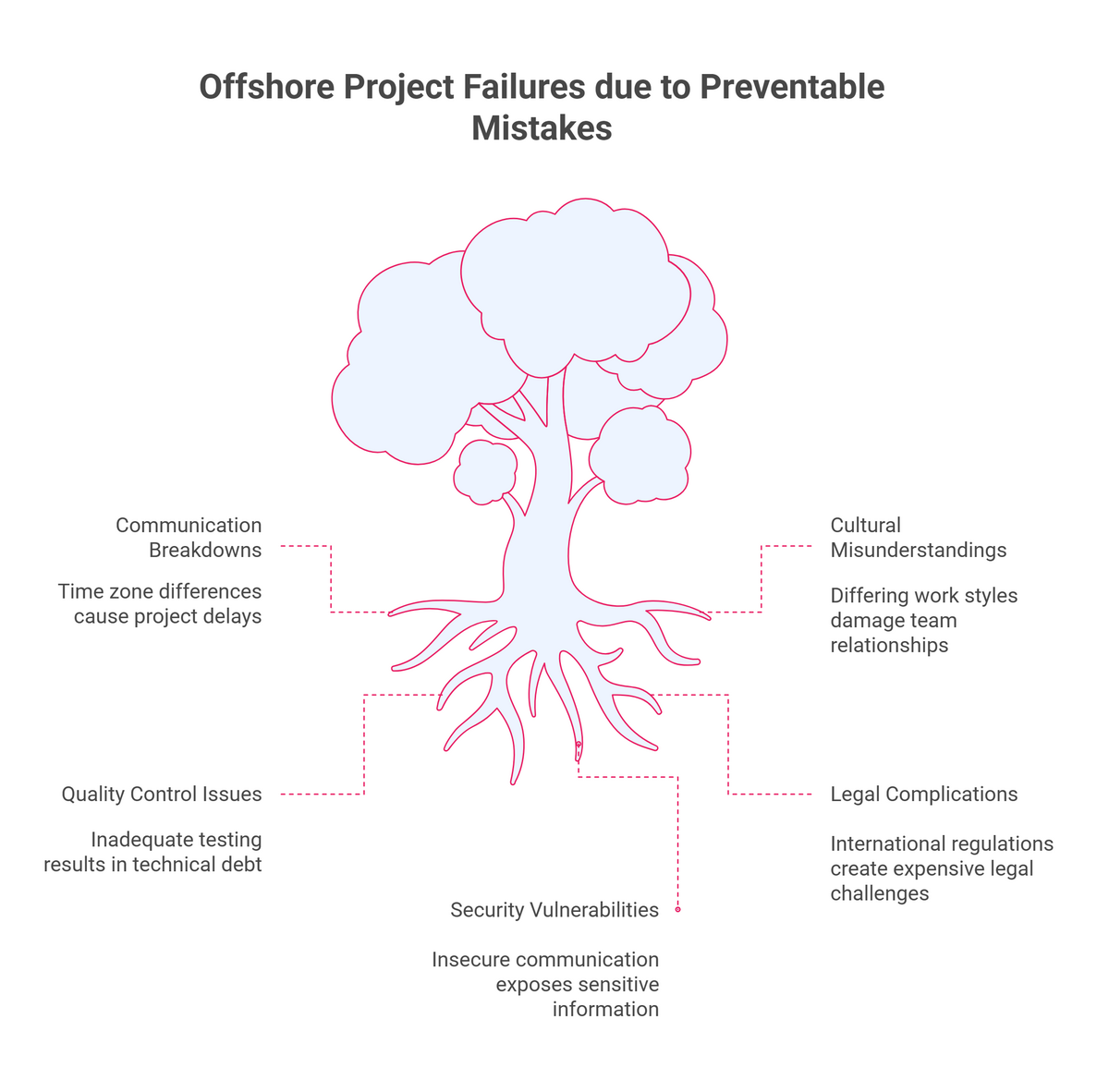
Offshore development failures often stem from preventable mistakes. Understanding these common pitfalls and implementing proven solutions protects your investment and ensures project success.
Communication Breakdowns
The Problem
Miscommunication across time zones leads to project delays, requirement misunderstandings, and frustrated teams. Language barriers compound these challenges, creating costly rework cycles.
Solution: Establish Clear Protocols and Regular Check-ins
Implement structured communication frameworks with defined channels for different message types. Schedule daily standups, weekly progress reviews, and monthly strategic discussions. Use asynchronous tools to bridge timezone gaps.
Cultural Misunderstandings
The Problem
Different work cultures, communication styles, and business practices create friction between teams. Misinterpreted feedback and conflicting work approaches damage relationships and productivity.
Solution: Invest in Cultural Awareness Training
Provide cultural awareness training for both teams. Educate about communication preferences, holiday schedules, and business customs. Foster cultural exchange sessions to build mutual understanding.
Quality Control Issues
The Problem
Inconsistent code quality, missed requirements, and inadequate testing result in technical debt. Distance makes quality monitoring challenging without proper systems.
Solution: Implement Robust Review Processes
Establish comprehensive code review procedures, automated testing protocols, and quality checkpoints throughout development cycles. Use collaborative tools for real-time assessment.
Legal Complications
The Problem
Complex international regulations, intellectual property disputes, and contract ambiguities create expensive legal challenges. Jurisdictional differences complicate dispute resolution.
Solution: Work with International Legal Experts
Engage legal professionals experienced in international software development contracts. Establish clear intellectual property ownership and dispute resolution mechanisms before project commencement.
Security Vulnerabilities
The Problem
Data breaches, inadequate access controls, and insecure communication expose sensitive information. Different security standards across regions create compliance risks.
Solution: Establish Comprehensive Security Protocols
Implement enterprise-grade security frameworks including encrypted communication, secure repositories, and regular audits. Establish clear data handling procedures and access policies.
The Key Insight
Most offshore development failures result from poor initial screening and inadequate partner selection. Companies that invest in thorough evaluation processes using modern screening technologies avoid these pitfalls entirely.
The Best and Platforms for Offshore Hiring
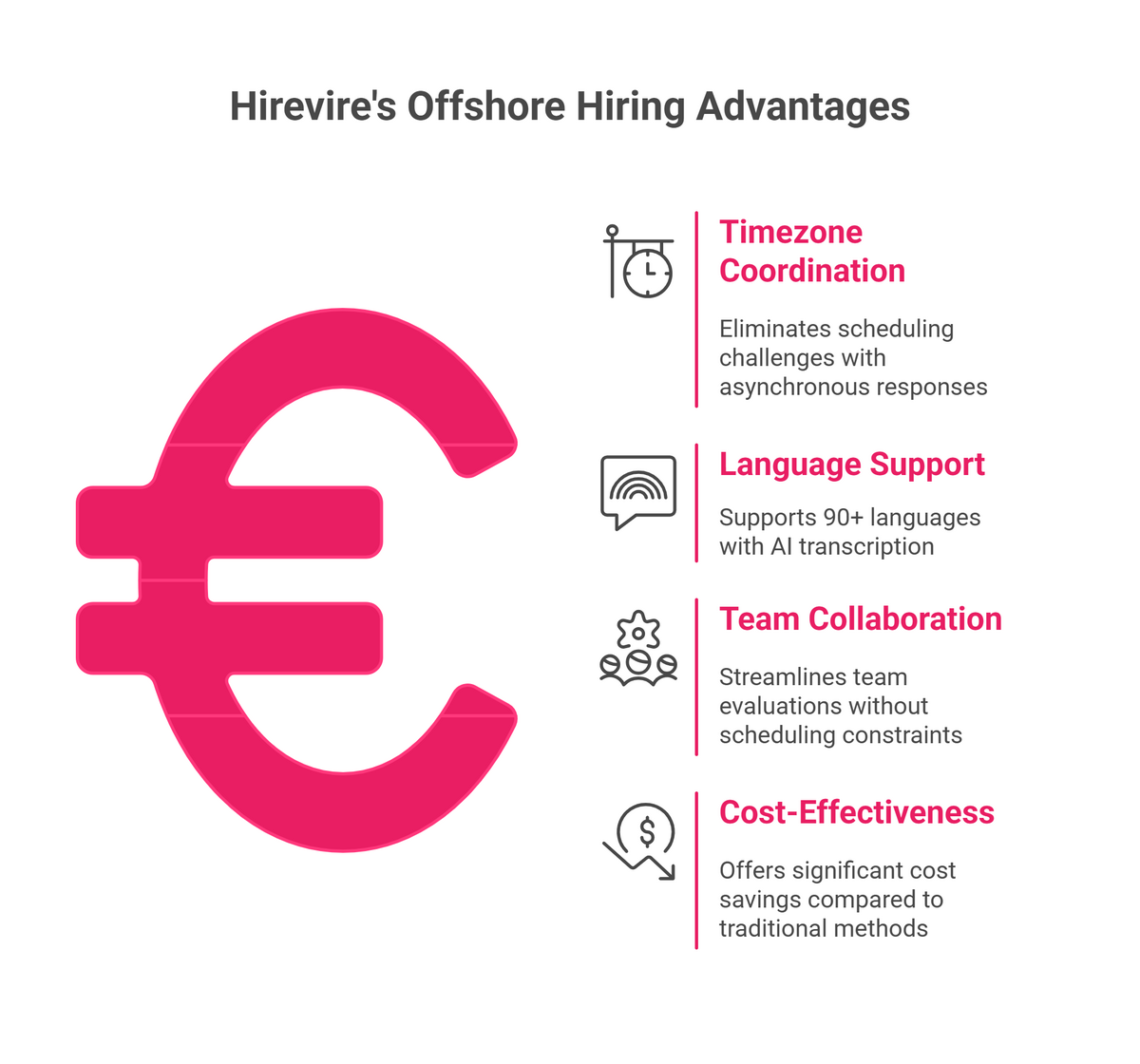
Selecting the right tools for offshore hiring determines your success in efficiently evaluating global talent. Modern platforms eliminate traditional barriers while improving candidate experience across time zones.
Interview and Screening Platforms
Hirevire - Leading Asynchronous Interview Platform
Hirevire revolutionizes offshore hiring through asynchronous video interviews that eliminate timezone coordination entirely. The platform enables candidates to record responses at their convenience while providing hiring teams with comprehensive evaluation materials.
Traditional Video Interview Tools
Conventional live video interview platforms require complex scheduling coordination across multiple time zones. These tools create significant barriers when evaluating offshore candidates due to timezone constraints.
Technical Assessment Platforms
Coding challenge platforms evaluate specific programming competencies. These tools work well in combination with asynchronous interviews for comprehensive candidate evaluation.
Portfolio Review Systems
Portfolio platforms allow candidates to showcase previous work and code samples, providing valuable context for technical discussions during interviews.
Comparison Table
| Platform | Key Features | Best For | Pricing |
|---|---|---|---|
| Hirevire | Async interviews, 90+ languages, team collaboration | Offshore hiring with timezone challenges | Starting at $39/month |
| Others | Live interviews, basic features | Traditional hiring | Higher costs + coordination overhead |
Why Hirevire Excels for Offshore Hiring
Eliminates Timezone Coordination Challenges
Hirevire's asynchronous approach removes the biggest obstacle in offshore hiring—coordinating schedules across time zones. Candidates record responses when convenient, eliminating scheduling delays.
Supports 90+ Languages with AI Transcription
Critical for global hiring, Hirevire's AI transcription supports over 90 languages, ensuring clear communication assessment regardless of candidate location or accent variations.
Streamlined Team Collaboration Features
Hiring teams can review recorded responses asynchronously and collaborate on candidate evaluations without scheduling constraints. Multiple stakeholders can assess candidates at their convenience.
Cost-Effective Pricing Structure
Starting at just $39/month, Hirevire provides exceptional value compared to traditional recruitment methods averaging $4,700 per hire. The platform eliminates coordination costs while improving candidate quality.
For offshore hiring success, choose tools that eliminate geographical barriers. Hirevire transforms offshore hiring from coordination nightmare into streamlined competitive advantage.
Success Stories and Case Studies
Real-world examples demonstrate how companies successfully leverage offshore development teams to achieve rapid growth and cost savings. These case studies showcase practical implementation strategies and measurable results.
Case Study 1: Tech Startup's Offshore Success
Challenge: Needed to Scale Development Team Quickly
A growing fintech startup faced urgent expansion demands but couldn't afford Silicon Valley developer salaries. Traditional offshore hiring methods created weeks of scheduling delays across multiple time zones, threatening critical product launch deadlines.
Solution: Used Hirevire for Efficient Offshore Screening
The company implemented Hirevire's asynchronous interview platform to evaluate offshore developers without timezone coordination challenges. Candidates recorded responses at their convenience while the hiring team collaborated on evaluations during regular business hours.
Results: Hired 5 Developers in 30 Days, 50% Cost Savings
The startup successfully hired five senior developers from Eastern Europe within 30 days, achieving 50% cost savings compared to local hiring. The streamlined screening process eliminated scheduling bottlenecks and improved candidate experience, resulting in higher acceptance rates.
Case Study 2: Agency's Offshore Recruitment
Challenge: Managing Multiple Client Offshore Requirements
A recruitment agency struggled with complex offshore hiring processes for various clients, each requiring different skill sets and cultural fits. Coordinating live interviews across multiple time zones created operational bottlenecks and client dissatisfaction.
Solution: Implemented Hirevire for Standardized Screening
The agency standardized their offshore screening process using Hirevire's platform, creating consistent evaluation frameworks while eliminating timezone coordination complexity for both candidates and clients.
Results: 40% Faster Screening Process, Improved Client Satisfaction
The agency achieved 40% faster screening cycles and significantly improved client satisfaction scores. Standardized evaluation processes enhanced candidate quality while reducing operational overhead and improving scalability.
Future of Offshore Development
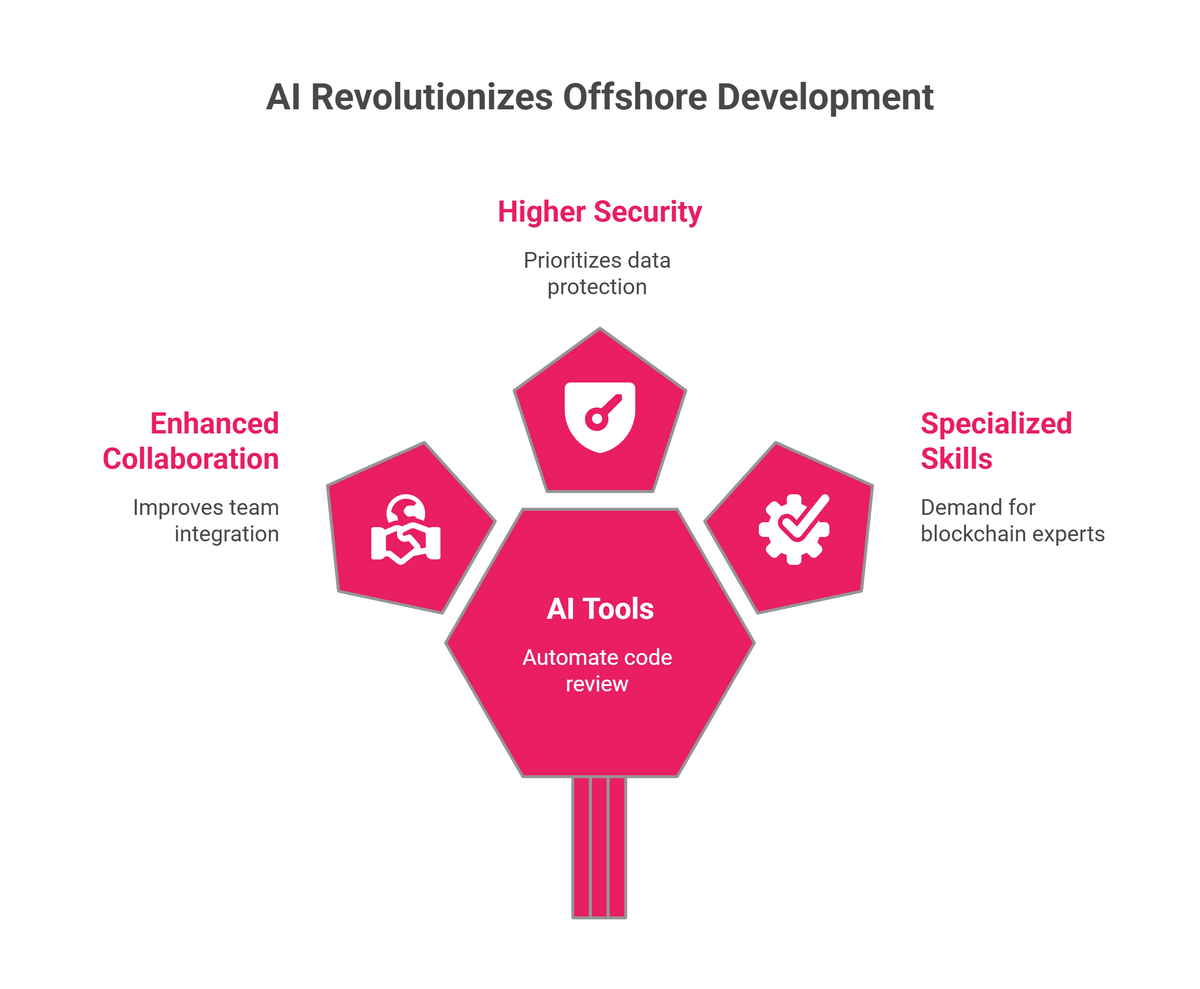
The offshore development landscape continues evolving rapidly, driven by technological advancement and changing global work patterns.
Emerging Trends
AI-Assisted Code Review and Development
AI tools revolutionize offshore development through automated code reviews and development assistance, enhancing collaboration while maintaining quality standards.
Increased Focus on Cybersecurity
Growing cyber threats drive enhanced security protocols in offshore partnerships. Companies prioritize security-certified developers and advanced data protection measures.
Growth in Specialized Niches (Blockchain, AI/ML)
Demand surges for offshore specialists in blockchain, machine learning, and AI implementation. These specialized skills command premium rates.
Evolution of Remote Work Technologies
Advanced collaboration platforms and real-time development environments improve offshore team integration across geographical boundaries.
Market Predictions
Continued Growth in Offshore Development Market
The offshore market projects sustained expansion as companies embrace global talent strategies.
Increased Demand for Senior-Level Offshore Talent
Companies increasingly seek experienced offshore architects rather than junior developers, driving quality improvements.
Integration of AI Tools in Development Workflows
AI-powered development tools will become standard, enabling faster delivery and enhanced quality assurance.
Conclusion
Building exceptional offshore development teams has never been more achievable. This guide has revealed the roadmap to offshore hiring success while highlighting critical factors that separate winning companies from coordination chaos.
Key Takeaways
Offshore development offers significant cost savings and access to global talent unavailable locally. Companies achieve 40-60% cost reductions while accessing specialized expertise in blockchain, AI/ML, and mobile development.
Success depends on thorough screening, clear communication, and proper legal framework. Successful offshore partnerships invest in upfront evaluation processes rather than rushing to hire based on resumes alone.
Asynchronous video interviews solve major timezone and coordination challenges that plague traditional offshore hiring. Smart companies leverage technology that eliminates geographical barriers entirely.
Tools like Hirevire streamline the offshore hiring process by transforming evaluation from logistical nightmare into competitive advantage. AI transcription in 90+ languages and team collaboration make offshore hiring more efficient than local hiring.
Your Next Steps
Start your offshore hiring journey with Hirevire's proven platform and join hundreds of companies that have transformed their recruitment process.
Take advantage of cost-effective screening starting at $39/month compared to average $4,700 traditional cost-per-hire.
Build your global development team with confidence using the right tools and strategies for success.
Ready to hire your offshore development team without timezone headaches? Start your Hirevire trial today.
FAQs
Common questions about offshore developer hiring reveal the challenges companies face and solutions that lead to successful partnerships. These answers provide practical guidance for navigating offshore development complexities.
Q: What are the biggest challenges when hiring offshore developers?
A: The main challenges include communication barriers, timezone differences, cultural misunderstandings, and quality control. Traditional live interviews create scheduling nightmares across multiple time zones, often delaying hiring timelines by weeks. Using tools like Hirevire's asynchronous interview platform helps overcome timezone issues by allowing candidates to record responses at their convenience, eliminating coordination complexity entirely.
Q: How do I ensure quality when hiring offshore developers?
A: Implement a thorough screening process using video interviews, technical assessments, and portfolio reviews. Hirevire's platform allows you to standardize questions and collaborate with your team on evaluations, ensuring consistent quality assessment. The AI transcription feature supports 90+ languages, enabling accurate evaluation of communication skills regardless of candidate location or accent variations.
Q: What's the average cost savings when hiring offshore?
A: Companies typically save 40-60% on development costs when hiring offshore, depending on the region and expertise level required. However, these savings only materialize with efficient hiring processes. Modern screening platforms like Hirevire start at just $39/month, dramatically reducing recruitment costs compared to traditional methods averaging $4,700 per hire.
Q: How do I handle intellectual property protection?
A: Use comprehensive contracts with clear IP ownership clauses, work-for-hire agreements, and confidentiality provisions. Consider registering IP in relevant jurisdictions. During the screening process, platforms like Hirevire allow you to include confidentiality discussions and IP awareness questions to assess candidate understanding before moving to final interviews.
Q: Which countries are best for hiring offshore developers?
A: Popular choices include India (cost-effective, large talent pool), Ukraine (high-quality, timezone overlap with Europe), Philippines (strong English skills), and Latin American countries (timezone alignment with US). Regardless of location choice, success depends on efficient candidate evaluation. Hirevire's asynchronous approach works equally well across all regions, eliminating geographical barriers to quality assessment.
Q: How do I manage communication across different time zones?
A: Establish clear communication protocols, use asynchronous communication tools, schedule overlap hours, and maintain comprehensive documentation. Asynchronous video interviews through platforms like Hirevire eliminate scheduling conflicts entirely, allowing you to evaluate candidates thoroughly without a single timezone coordination meeting.
Q: What legal considerations should I keep in mind?
A: Key considerations include contract structure, IP protection, compliance with international regulations (GDPR, etc.), tax implications, and dispute resolution mechanisms. Start legal discussions early in the hiring process by including compliance-related questions in your screening interviews to identify candidates familiar with international business requirements.
Q: How long does it take to hire a good offshore developer?
A: With efficient screening processes like Hirevire's asynchronous interviews, you can complete initial screening within 1-2 weeks, followed by 1-2 weeks for final interviews and contract negotiation. This timeline represents a 60-70% improvement over traditional offshore hiring methods that require extensive coordination and multiple rescheduling attempts.

